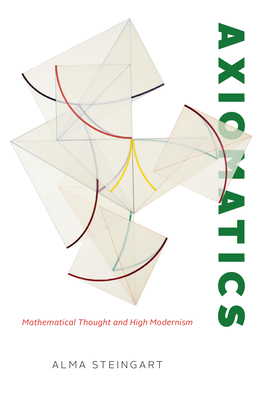
Axiomatics: Mathematical Thought and High Modernism
Description
The first history of postwar mathematics, offering a new interpretation of the rise of abstraction and axiomatics in the twentieth century.
Why did abstraction dominate American art, social science, and natural science in the mid-twentieth century? Why, despite opposition, did abstraction and theoretical knowledge flourish across a diverse set of intellectual pursuits during the Cold War? In recovering the centrality of abstraction across a range of modernist projects in the United States, Alma Steingart brings mathematics back into the conversation about midcentury American intellectual thought. The expansion of mathematics in the aftermath of World War II, she demonstrates, was characterized by two opposing tendencies: research in pure mathematics became increasingly abstract and rarified, while research in applied mathematics and mathematical applications grew in prominence as new fields like operations research and game theory brought mathematical knowledge to bear on more domains of knowledge. Both were predicated on the same abstractionist conception of mathematics and were rooted in the same approach: modern axiomatics.
For American mathematicians, the humanities and the sciences did not compete with one another, but instead were two complementary sides of the same epistemological commitment. Steingart further reveals how this mathematical epistemology influenced the sciences and humanities, particularly the postwar social sciences. As mathematics changed, so did the meaning of mathematization.
Axiomatics focuses on American mathematicians during a transformative time, following a series of controversies among mathematicians about the nature of mathematics as a field of study and as a body of knowledge. The ensuing debates offer a window onto the postwar development of mathematics band Cold War epistemology writ large. As Steingart’s history ably demonstrates, mathematics is the social activity in which styles of truth—here, abstraction—become synonymous with ways of knowing.
Praise for Axiomatics: Mathematical Thought and High Modernism
“Mathematics has undergone tremendous changes, especially during the twentieth century, when it pushed ever deeper into the realm of abstraction. This upheaval even involved a redefinition of the definition itself, as Steingart explains in Axiomatics. A historian of science, Steingart sees this revolution as central to the modernist movements that dominated the mid-twentieth century in the arts and social sciences, particularly in the United States.”
— Nature
“Steingart provides a history of mathematical thinking over the twentieth century: a compelling review of the increased abstraction of mathematical thought as well as its embrace of deep exploration of alternative axiomatic systems.”
— Public Books
“Steingart takes a wide-angle view on mid-twentieth-century mathematics, connecting the axiomatic movement with high abstraction in modern art, structuralism in the social sciences, the New Criticism in literary criticism, and the deep unease felt by many scientists and mathematicians in the wake of World War II as their research became ever more entangled with military applications. Unfailingly lucid and alert to sympathetic resonances between apparently disparate realms, Steingart positions modern mathematics squarely in the center of high modernism.”
— Lorraine Daston, author of Rules: A Short History of What We Live By
“This sophisticated and wide-ranging book examines mid-century American mathematics as a species of high modernism, both in its pure form and in applied mathematics. It looks at how it was supported, why it was advocated, how and why it was compared to contemporary abstract art, how the evolving ideas of abstraction played out in the Cold War, and how this even affected the writing of the history of mathematics. It is a major addition to and critique of the literature that presents modern mathematics as a species of modernism, and it should be read by every historian of modern science and indeed by anyone interested in how abstract ideas have shaped the modern world.”
— Jeremy Gray, author of Plato’s Ghost: The Modernist Transformation of Mathematics
“American mathematics was in the midst of a puzzling contradiction at midcentury: applied mathematics appeared triumphant even as many mathematicians promoted abstraction and rejected the idea that utility was important. Steingart’s brilliant book has finally resolved this puzzle. Far from standing in opposition, mathematics’ utility and idealism, its calculations and foundations, were historically intertwined with the concept of axiomatics. By masterfully weaving together the work of artists and mathematicians, mundane academic conference proceedings and philosophical treatises, Steingart has written an essential guide to the transformation of postwar mathematics.”
— Christopher J. Phillips, author of The New Math: A Political History
“The push for axiomatic reasoning, so central to twentieth-century mathematics, extended by 1950 to elite social science. But the power of this abstract logic, never absolute, was in retreat by the 1990s. Although the most familiar of these challenges took form as a new cult of data, Steingart’s most engaging arguments explore a new fascination with mathematical historicism.”
— Theodore M. Porter, author of Trust in Numbers: The Pursuit of Objectivity in Science and Public Life
"Alma Steingart’s Axiomatics: Mathematical Thought and High Modernism is an attempt to combine the story of abstraction with developments outside of mathematics. . . . she presents this material from a very interesting and well-informed perspective."
— American Mathematical Monthly
"The mathematicians of the later period explored here (approximately 1945–70) were shaped by their wartime experiences, the postwar growth of the military-industrial complex, and anticommunism. For chapter themes, Steingart divides abstraction in mathematical research into six dimensions: pure, applied, human, creative, unreasonable, and historical. The last chapter provides a clear, thorough survey of the notorious1970s debates over mathematics historiography. Most of the discussion of mathematics is conceptual rather than technical, so the book is broadly accessible to an academic audience."
— Choice
